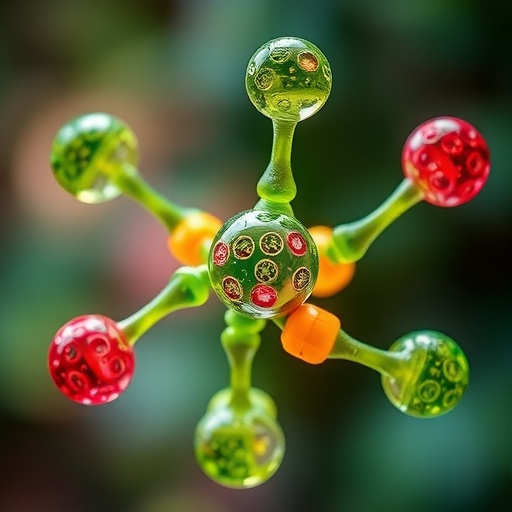As global energy demands surge and the urgency to address climate change escalates, scientific communities worldwide are spearheading revolutionary approaches to redefine chemical manufacturing toward sustainability. A groundbreaking review led by Dr. Yong Jiang in collaboration with experts from Fujian Agriculture and Forestry University, the Technical University of Denmark, and Tsinghua University unpacks the burgeoning realm of “biohybrid” synthesis systems—sophisticated platforms that intricately merge living microbial cells with cutting-edge materials science. This fusion is unlocking unprecedented pathways for producing chemicals cleanly and efficiently, offering promising prospects for a greener industrial future.
Biohybrid systems epitomize a synthesis of biology and materials chemistry, leveraging engineered inorganic materials interfaced with microbial entities to catalyze chemical transformation. These systems uniquely exploit renewable energy sources—including direct current electricity, solar irradiation, and emerging drivers like water evaporation and mechanical energy—to activate abiotic components within the hybrid construct. Upon activation, these components facilitate electron transfer processes to microbial cells, which then convert simple feedstocks like carbon dioxide and water into value-added compounds. Such integration capitalizes on the superior specificity and mild reaction conditions of biological catalysts while enhancing reaction efficiency through advanced materials.
A focal point underscored in the review is microbial electrosynthesis (MES), a technique wherein biohybrid electrodes mediate the fixation of CO₂ into commercially relevant chemicals and biofuels. MES operates under ambient temperature and pressure, distinguishing itself from traditional high-energy-consuming chemical routes. At the core of MES are meticulously designed electrodes that, through electronic excitation, donate electrons directly or via intermediaries to microbes, empowering them to metabolize carbon dioxide into a diverse portfolio of products ranging from simple organics to complex polymers. The selectivity inherent to biological systems ensures fewer undesired byproducts, underscoring the approach’s environmental appeal.
Recent advances shine a spotlight on formate-mediated tandem catalysis—a novel strategy leveraging formate as an electron shuttle between electrode surfaces and microbial metabolism. This approach circumvents direct electron transfer constraints by producing formate electrochemically, which microbes subsequently assimilate, leading to accelerated rates of bio-conversion. The dual role of formate as both an electron carrier and a carbon source amplifies the efficiency of MES platforms, forging a pathway toward scalable, renewable chemical synthesis that is both energy- and carbon-conservative.
The review further elucidates the progress in semi-artificial photosynthesis, a hybrid technique that outperforms natural photosynthesis in solar energy harnessing. By integrating semiconductor materials with whole microbial cells, the system channels photon energy to drive biochemical pathways more efficiently than chlorophyll-based mechanisms alone. This paradigm shift enables direct synthesis of target chemicals like methane, acetate, and biodegradable plastics, transforming sunlight and atmospheric carbon into tangible commodities with reduced greenhouse gas footprints.
Beyond solar and electric inputs, frontier research is exploring how biohybrids can tap into ubiquitous environmental energies. Innovative materials capable of harvesting hydrovoltaic energy—generated from natural water cycle phenomena—and piezoelectricity arising from mechanical forces are being integrated to create self-sufficient biohybrid reactors. These engines of green chemistry are envisioned to operate off-grid in diverse environments, expanding conceivable applications from industrial wastewater remediation to enhancing soil carbon sequestration in agroecosystems.
Critical to the future advancement of biohybrid systems is the profound understanding and optimization of interfacial electron and energy transfer mechanisms. The complex interplay between abiotic materials and living cells dictates overall efficiency and stability but remains a significant scientific challenge. The review advocates for intensified interdisciplinary research that delves into molecular-level interactions, material surface chemistry, and cellular metabolic adaptation to inform the rational design of next-generation biohybrid interfaces with enhanced performance and durability.
On the microbial engineering front, broadening the product slate beyond conventional chemicals necessitates advanced synthetic biology tools. Tailoring microbial metabolic pathways to produce a wider array of high-value compounds—from specialty chemicals to novel polymers—while maintaining compatibility with material interfaces will be essential. The integration of genetic optimization with material innovations is projected to accelerate the emergence of versatile and economically viable biohybrid production platforms.
Moreover, life cycle assessments and techno-economic analyses embedded in the review emphasize the sustainability advantages of biohybrid technologies. By converting waste carbon streams and utilizing renewable energy drivers, these systems promise to circumvent the carbon-intensive footprint typical of petrochemical processes. The scalability of biohybrids is further supported by the modular nature of their components, allowing flexible adaptation for various industrial sectors and geographic contexts.
Co-author Dr. Shungui Zhou remarks on the transformative potential of biohybrids: “Harnessing the synergy between engineered materials and living cells is unlocking unprecedented avenues for environmental protection. Exploring untapped energy modalities such as magnetic and thermal inputs alongside existing electric and solar drivers could revolutionize sustainable chemical synthesis.” This visionary perspective encapsulates the multidisciplinary ambitions necessary to translate biohybrid technologies from laboratory concepts to impactful industrial solutions.
While significant hurdles remain—particularly in fine-tuning charge transfer interfaces and microbial resilience—the momentum garnered by recent breakthroughs provides optimism. Formate-mediated processes exemplify a salient success, demonstrating how minimal modifications in electron carriers can yield remarkable gains in system efficiency. Such incremental yet impactful innovations mark critical milestones on the path to realizing net-zero chemical manufacturing frameworks.
In summary, biohybrid synthesis systems represent a confluence of biology, materials science, and renewable energy technologies that collectively redefine the paradigm of chemical manufacturing. Their capability to convert abundant, low-cost inputs like CO₂ and sunlight into valuable chemicals under benign conditions heralds a transformative leap towards sustainability. Continued interdisciplinary research, combined with strategic scaling efforts, will be paramount in actualizing the promise of biohybrids as cornerstones of a resilient and low-carbon chemical industry.
For those intrigued by the technological nuances, the comprehensive open-access review is available in Energy & Environment Nexus, offering an in-depth exploration of cutting-edge biohybrid strategies and future vistas in sustainable synthesis.
Subject of Research: Not applicable
Article Title: Biohybrids for sustainable chemical synthesis
News Publication Date: 22-Sep-2025
Web References:
Energy & Environment Nexus Journal
DOI link
References:
Jiang Y, Ren G, Zhang Y, Liang P, Zhou S. 2025. Biohybrids for sustainable chemical synthesis. Energy & Environment Nexus 1: e003.
Image Credits: Yong Jiang, Guoping Ren, Yifeng Zhang, Peng Liang & Shungui Zhou
Keywords: Microbial ecology, Ecology, Microbiology




